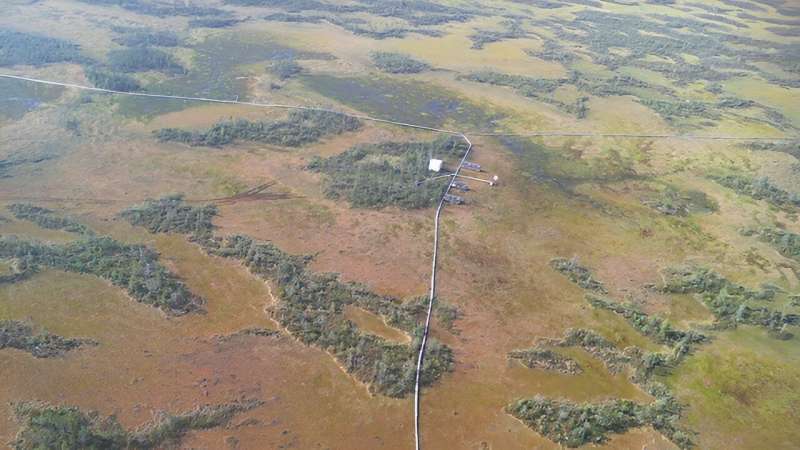This article has been reviewed according to Science X's editorial process and policies. Editors have highlighted the following attributes while ensuring the content's credibility:
fact-checked
peer-reviewed publication
trusted source
proofread
Scientists explore hidden dynamics in peat under mosses and shrubs

Global warming is causing extensive changes to peatland vegetation in Europe and Western Siberia, with consequences for soil composition and the peatlands' ability to sequester carbon. An EPFL-led study has examined the mechanisms behind these complex processes.
Peatlands are significant carbon sinks, meaning they're potential time bombs when it comes to greenhouse gas emissions. Yet a lot remains to be learned about some of the processes in these unique ecosystems—information that'll be key to better understanding the challenges we'll face as a result of climate change.
For the past several years, Alexandre Buttler has been studying the underlying mechanisms of peatlands. Buttler is an EPFL professor emeritus and former head of the Ecological Systems Laboratory at EPFL's School of Architecture, Civil and Environmental Engineering (ENAC), and his latest research was published recently in Global Change Biology. An invited commentary on Buttler's work by David Johnson was published in the same journal.
"We wanted to investigate the processes that are characteristic of these ecosystems, taking into account both above-ground factors, like the climate and vegetation, and below-ground ones, such as microorganisms," says Buttler. "We know that the presence of certain plants can influence soil composition, but we aren't clear on what all the effects are underground."
Peatlands form in wet climates with relatively cool temperatures, like in the Nordic countries. In Switzerland, peatlands can be found at higher altitudes in the Jura and the Alpine foothills. The peat itself is created from the build-up of decaying plants, as the impermeable, oxygen-poor soil and waterlogging in these areas slow the organic decomposition process. Peatland vegetation consists primarily of Sphagnum mosses.
"These mosses 'engineer' both the physical and chemical properties of the peatland they grow in, creating a sponge-like soil that's so acidic that it poisons other organisms," says Buttler. "As a result, peatlands consist of relatively limited biotopes with extremely specific properties." But scientists have observed that in recent years, peatland vegetation has been changing due to global warming, with ericoid shrubs increasingly encroaching on Sphagnum mosses.
Experiments and observations
To get a better idea of exactly what's going on, Buttler and his research group, along with scientists in France, Poland and Siberia, carried out a two-pronged study of peatlands in France, Poland and Western Siberia between 2012 and 2014.
These regions all have the same type of vegetation but different climate conditions. The research team started by running field experiments at a site in Poland to determine which plant species was the most likely to encroach on Sphagnum moss. They cut out large blocks of peat and manipulated the water table level and air temperature in each of the blocks.
"We observed how plants reacted to the altered conditions, and found that a vascular plant called Andromeda polifolia—an ericoid shrub in the same family as blueberries—was best able to adapt because it proliferates easily in dry environments," said Buttler.
Using Andromeda polifolia as an indicator, the researchers then took peatland measurements in each of the three regions. They found that high growth rates of Andromeda polifolia are associated with significant alterations in soil biology and geochemistry, which subsequently triggers a domino effect across the ecosystem. That's because, unlike Sphagnum moss, Andromeda polifolia is a vascular plant with large amounts of polyphenol in its leaves.
The presence of polyphenol, an antibacterial agent, disrupts the delicate balance of microorganisms in peatlands and causes more dissolved organic nitrogen to be stored underground. What's more, it also allows nematodes and fungi to flourish at the expense of bacteria. These fungi draw organic nitrogen from the soil and supply it to Andromeda polifolia roots as a nutrient.
Sphagnum moss must therefore compete with the ericoid shrub for survival, and the more of the shrub that's present, the greater the alteration in the soil chemistry and microbiome. Specifically, the soil loses many of the enzymes that decompose organic matter, resulting in less plant decay and more peat build-up—which might lead one to believe that the carbon contained in the peatlands is less likely to be released.
Can we therefore conclude that ericoid shrub encroachment is good news in the fight against global warming, since it means sequestered carbon can be preserved underground? Buttler isn't sure. "There are many other factors to consider and more research is needed before we can give a clear answer," he says. "Variations in the air concentrations of nitrogen and CO2, as well as the exact role that fungi play, could impact our conclusions."
Buttler's research nevertheless provides important insight into the functioning of peatlands, especially since it pulls together two different scientific methods: short-term experiments, and long-term observations of effects that play out over time.
More information: Alexandre Buttler et al, Ericoid shrub encroachment shifts aboveground–belowground linkages in three peatlands across Europe and Western Siberia, Global Change Biology (2023). DOI: 10.1111/gcb.16904
David Johnson, Why Andromeda is no goddess for the sustainability of bogs, Global Change Biology (2023). DOI: 10.1111/gcb.16930
Journal information: Global Change Biology
Provided by Ecole Polytechnique Federale de Lausanne




















